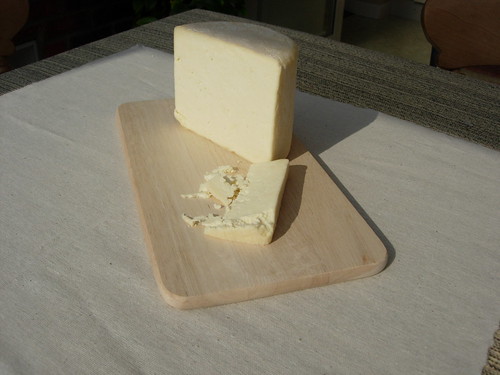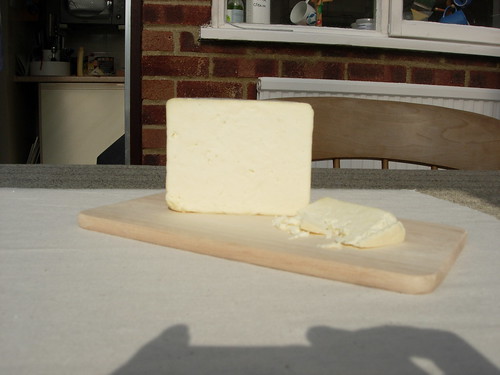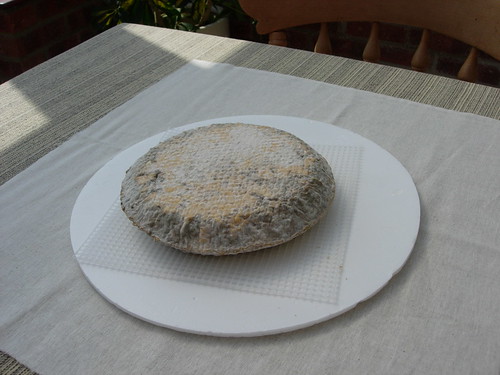Page 2 of 4

Posted:
Tue May 09, 2006 4:29 pmby jenny_haddow
Are cheeses like emental hard cheeses? I'm intrigued as to how the holes are produced, what's the secret?
Cheers
Jen

Posted:
Tue May 09, 2006 6:23 pmby Rik vonTrense
AH Glasshopper....you must walk before you can run....
Ementhalers are a hard cheese and are pressed and the holes are formed by a special bacteria .
One of the most difficult cheese in the world to make successfully. The eyes as they are termed are formed by the use of Propionibacterium shermani this in conjunction with the endemic bacterial flora in the areas where emental is traditionally produced.
You should prefereably try to create a cheese to suite your conditions rather that try to create the conditions to suit your cheese.
The weight of an ementhaler cheese is 220/225 lbs the cheese size is 100cm x 25cm. and uses 1400 litres of milk to make.
The starter cultures are streptococcus thermophilus S.lactis, lactobacillus helveticus, and propionbacterium shermani and some cheesemakers also add lactobacillus bulgaricus.
Rennet is used and the curds are cut to the size of rice grains scalding and pitching takes the temperature up to 128F allowing a pH OF 6.4 to develop
The final press overnight is 15/20 cwt per cheese.
The cheese is then salted in a brine bath at 23% salt at 10C for three days. The cheese is rubbed with salt every day and warm ripening takes 6 weeks for eyehole formation,
Cold ripening takes 8 weeks and then store for 12 months at 85/90 % RH
see what I mean Glasshopper ??
.

Posted:
Tue May 09, 2006 6:35 pmby Rik vonTrense
If you look at the Gouda recipe you will find a brine bath there for a 20% solution.
You can keep a brine bath but you must add salt to it for the salt you take out of it. Usually 20% saturation is all the water can comfortable dissolve. salt over the 20% will nt dissolve.
Different cheeses have different times for salting.
I will post a simple Brie/Camembert recipe as it is exactly the same but a brie is just a big camembert.

Posted:
Tue May 09, 2006 6:40 pmby Paul Kribs
Laughing my **** off Rik, nice one, I do like a sense of humour..
Although I have no intention yet of joining the cheesemaking fraternity, I have been reading the posts with the utmost interest. I don't quite follow the processes but interesting reading nonetheless.. and I bow to your knowledge 'oh master'

ps.. she couldn't buy my normal supply of gorgonzola piquante and bought some grotty gorgonzola that had no real flavour, and was still very wet.. very young.. waste of time. I can see why you do it.
Regards, Paul Kribs

Posted:
Wed May 10, 2006 7:56 amby jenny_haddow
Hi Lik
I see what you mean!
Cheers
Glasshopper.

Posted:
Wed May 10, 2006 12:34 pmby welsh wizard
Hi all glad the photos are getting put on the site. Has anyone yet done a start to finish photo shoot?
Cheers WW

Posted:
Wed May 10, 2006 12:54 pmby jenny_haddow
Hi WW
Rik's done a step by step tutorial in the soft cheese section. It's very well explained and pictured.
Jen

Posted:
Fri May 12, 2006 9:05 amby jenny_haddow
Cut into the Lancashire this morning, and I agree with Franco's verdict on the flavour, just beautiful. Here's a picture:


Here's the latest dvelopment on the small collander cheese:

I've got dinner guests tomorrow night and the cheese course will be home produced. Stilton, Lancashire a couple of variations of Neuchatel. I'm not going to say a word, just wait to see if there are any comments.
Cheers
Jen

Posted:
Sun May 14, 2006 8:41 amby jenny_haddow
Well, the dinner guest went home with a 'doggy bag' of cheese, and supplies are now seriously depleted so I shall have to get some more on the go.
I must say it is immensely satisfying to go to the supermarket and walking past the cheese, sausage and bacon counters knowing you've got better at home and all home made.
Jen

Posted:
Sun May 14, 2006 9:08 amby Wohoki
Smugness is part of the appeal

I served a home cured, smoked and baked ham to guests on Friday, and they spent all evening trying to weedle the name of my butcher out of me, as "he must be a genius"


Posted:
Sun May 14, 2006 10:47 pmby jenny_haddow
'We happy few...'

Posted:
Sun May 14, 2006 11:12 pmby pokerpete
jenny_haddow wrote:Well, the dinner guest went home with a 'doggy bag' of cheese, and supplies are now seriously depleted so I shall have to get some more on the go.
I must say it is immensely satisfying to go to the supermarket and walking past the cheese, sausage and bacon counters knowing you've got better at home and all home made.
Jen
For what it's worth Lancashire 'Crumbly' cheese was made, in the days before refrigeration, by keeping the the curds from the first day, and then the second. The third days curds were mixed with the previous two days curds, thus resulting in the difference with other cheeses.
Any comments?

Posted:
Mon May 15, 2006 5:36 amby Rik vonTrense
Pete....
I don't think Franco went to the trouble of doing a three day curds and then mixing them but he does have a distinct advantage over us southerners being in the right region for the proper milk.
I have never been tempted to open a cheese that young but I suppose it does have it's merits.
But remember with all cheeses they should be out of the fridge for at least one hour before consumption as this gives it time to produce it's finest flavours.
Mind you my Dutch Gouda which is my first attempt at this cheese, is looking very well and very mature it has a nice hard rind on it which has gone a nice yellow and it very firm to the touch much like a six month old cheddar.
I really am tempted to open it....even if it has no flavour yet the kids will eat it on toast, if it melts.....or on a Pizza.
.

Posted:
Mon May 15, 2006 4:18 pmby jenny_haddow
It's very interesting to read the traditional methods of making the cheeses we know so well, but I suppose the best we can claim when making it ourselves is the it is in the 'style of'...... Having said that, it still tastes very good for something produced so simply. I must say though, the simplicity of production is down largely to some first class instruction from Rik
Cheers
Jen

Posted:
Mon May 15, 2006 6:11 pmby Rik vonTrense
Once you have got the idea of your curds and how they should look and taste you are half way there..... I always taste my curds after they are cooked.
most other cheeses are just slight variations on temperatures or washing the curds by dililuting them this takes away some of the acidity.
I enjoyed making that Gouda and I think I will try for an Edam as well as another Gouda.
With the traditional cheddar method the curds are wrapped in a stilton bundle after handing and draining and this stilton bundle is pressed with a 10 lbs weight between two boards.
After taking out of the bundle the curd block is like a very thick pancake.
This is cut in slices and allowed to drain it is then reduce to half the size
yet again this is the term "Cheddaring" it is allowing the whey to drain naturally.
They say at this stage that the curd resembles the texture of cooked chicken breast meat and it does it tears in a way that cooked chicken tears.
When the curds have been reduced three times and finished draining they are then milled and the salt added before being packed into a cheesecloth lined mould for pressing,.
.


